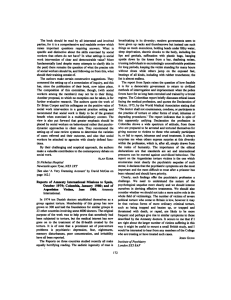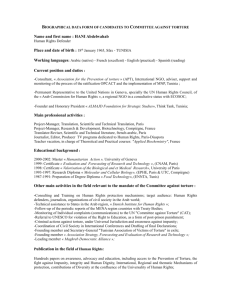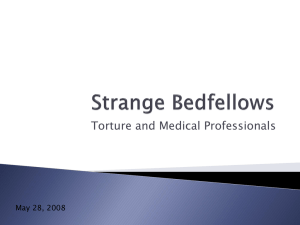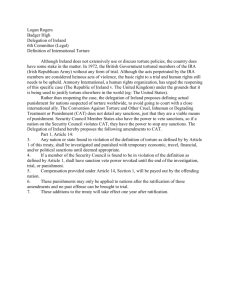Film and TV producers see torture as entertainment AZ Central.com, AZ
advertisement
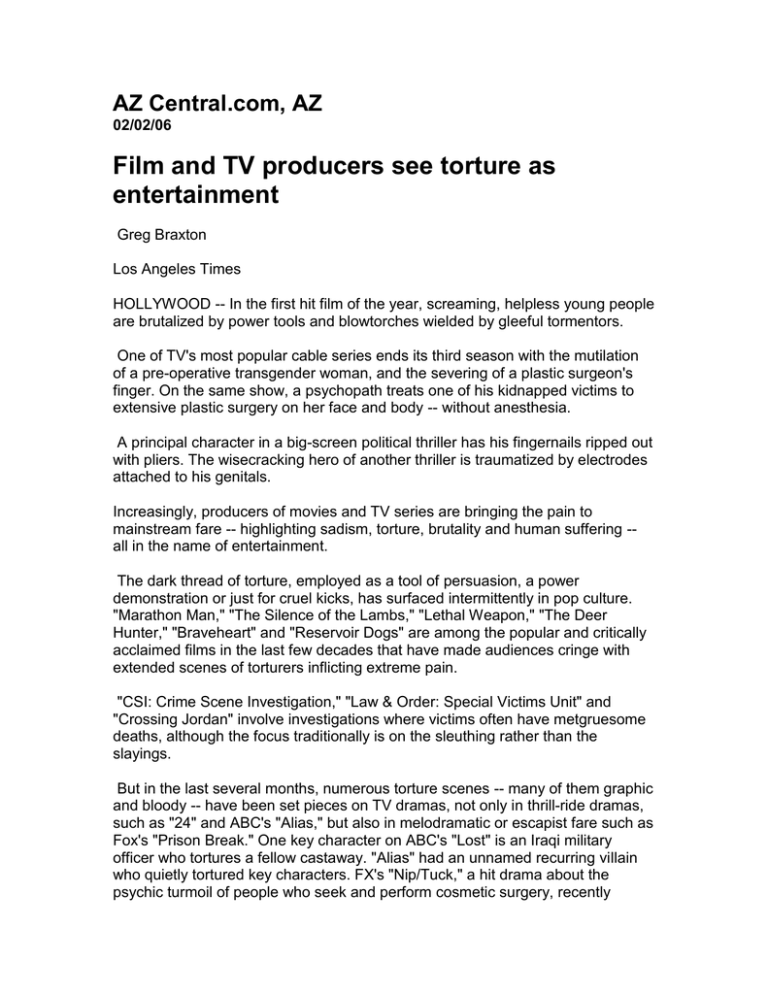
AZ Central.com, AZ 02/02/06 Film and TV producers see torture as entertainment Greg Braxton Los Angeles Times HOLLYWOOD -- In the first hit film of the year, screaming, helpless young people are brutalized by power tools and blowtorches wielded by gleeful tormentors. One of TV's most popular cable series ends its third season with the mutilation of a pre-operative transgender woman, and the severing of a plastic surgeon's finger. On the same show, a psychopath treats one of his kidnapped victims to extensive plastic surgery on her face and body -- without anesthesia. A principal character in a big-screen political thriller has his fingernails ripped out with pliers. The wisecracking hero of another thriller is traumatized by electrodes attached to his genitals. Increasingly, producers of movies and TV series are bringing the pain to mainstream fare -- highlighting sadism, torture, brutality and human suffering -all in the name of entertainment. The dark thread of torture, employed as a tool of persuasion, a power demonstration or just for cruel kicks, has surfaced intermittently in pop culture. "Marathon Man," "The Silence of the Lambs," "Lethal Weapon," "The Deer Hunter," "Braveheart" and "Reservoir Dogs" are among the popular and critically acclaimed films in the last few decades that have made audiences cringe with extended scenes of torturers inflicting extreme pain. "CSI: Crime Scene Investigation," "Law & Order: Special Victims Unit" and "Crossing Jordan" involve investigations where victims often have metgruesome deaths, although the focus traditionally is on the sleuthing rather than the slayings. But in the last several months, numerous torture scenes -- many of them graphic and bloody -- have been set pieces on TV dramas, not only in thrill-ride dramas, such as "24" and ABC's "Alias," but also in melodramatic or escapist fare such as Fox's "Prison Break." One key character on ABC's "Lost" is an Iraqi military officer who tortures a fellow castaway. "Alias" had an unnamed recurring villain who quietly tortured key characters. FX's "Nip/Tuck," a hit drama about the psychic turmoil of people who seek and perform cosmetic surgery, recently spotlighted physical turmoil with two simultaneous torture scenes, each set to a tango. It's unclear -- both to people who create torture-inflected scenarios and those who have taken note of their proliferation -- whether such themes reflect a pop culture recalibration or a blip on the screen. But for now, at least, torture seems inescapable. It has crept into "unscripted" series shows such as NBC's "Fear Factor," where willing contestants are trapped or doused with insects and small reptiles, and Fox Reality's upcoming "Solitary," in which isolated contestants are pushed to the physical and psychological brink. Torture scenes are featured in mainstream movies such as "Syriana" and "Kiss Kiss Bang Bang" and play a starring role in recent horror films, as campy boogeymen including hockey-masked Jason Voorhees and knife-fingered Freddy Krueger are replaced with the gnarly madmen of the just-released "Hostel" and the "Saw" franchise, who savage their victims so horribly that death might come as a welcome relief. "Hostel," for instance, features young travelers lured to a seemingly pleasant Slovakian hotel, where they wind up in an abandoned dungeon/warehouse and are stripped, shackled to chairs and offered up to wealthy, bored men paying exorbitant sums for the thrill of maiming and murdering them with blowtorches and power tools. "We're watching films where it's not about the big, scary monsters anymore," said Leo Quinones, host of a Saturday night call-in Los Angeles radio show devoted to comedies, action and horror movies. "Now humans are the worst monsters. It's all pretty riveting." There are concerns that the torture-for-entertainment wave, while enabling viewers to explore darker material safely, has minimized the true ramifications of perpetuating extreme pain. "One of the problems is when these depictions don't show the realistic consequences of violence," said Douglas Gentile, psychology professor at Iowa State University and the director of research for the National Institute on Media and the Family, a nonprofit advocacy group monitoring mass media for content that it deems is harmful to children and families. "These scenes gloss over the trauma that is caused," Gentile said. "There's nothing inherently wrong with watching violence, but what does the viewer learn? One of the problems is when the realistic consequences of violence and torture are not shown. It makes it seem like it's OK to commit these acts in the name of justice. It's a negative for society." Some creators of torture-tinged projects say there is a message behind the madness, insisting that that they are illuminating larger themes and using torture to enrich their storytelling. James Wan directed and co-wrote 2004's "Saw," which imprisoned two men in a filthy abandoned shower and other victims in deathtraps they could escape only by mutilating themselves or others. "I'm not a guy who does something just for the sake of doing it," he said. "I think there are lines that should not be crossed. But that's a personal thing -- it depends on how much tolerance one has. I'm a very squeamish guy, really. It ultimately comes down to what you want to achieve." Wan said "Saw" was not designed as atorture movie, even though that's what fans fixated on, but as a comment on people who don't value life. "I feel if you're going to show scenes like that, you better have something to say," he said. "It shouldn't be just about violence or torture. If people get that larger point, it's awesome." Dana Walden, president of 20th Century Fox Television, which produces "24" as well as "Prison Break," set in a prison populated with vicious inmates, added: "It's not about random abuse or torture. Such depictions are believable or organic action that takes place within the stories being told." "Hostel" writer and director Eli Roth said he chose torture scenes to express his frustration over government and world affairs. "Right now we're at war, and then you have Hurricane Katrina, where there are people on roofs screaming for help," said Roth. "I have this feeling that civilization could collapse, and that if you go overseas, you could get killed, that you could be in the middle of nowhere, and that someone could kill you and no one would find you. This film is also about the dark side of human nature. Everyone's life has a price. I want the audience to feel guilty. I want them to feel sick to their stomach, but by the end they're screaming for blood. Everyone has this evil within them." He scoffed at concerns over the relentless violence in "Hostel": "It's not my job to be anyone's parent. Everybody knows it's fake, everybody knows it's pretend. What's scarier is war, real-life violence." Peter Block, president of acquisitions and co-productions for Lions Gate, the studio behind "Hostel" and the "Saw" films, finds that there's a case to be made, too, that extreme themes provide simple catharsis. The more pain protagonists suffer, he said, the more satisfying the retribution when the tables get turned: "It's like a setup -- eventually it comes around to payback," Block said. "Audiences suffer right along with the person being tortured, so they can really cheer when things get turned around." Bottom line, some people argue, it's fantasy -- fantasy that millions find compelling. "Fortunately, severe violence and torture are not things that most people experience," said Nick Santora, a supervising producer of "Prison Break." "But there does seem to be a morbid fascination surrounding it. When it's done properly, it is, for lack of a better word, entertaining." Nevertheless, one expert said, the psychological price of such entertainment might be too high. Thomas Doherty, chairman of the film studies program at Brandeis University and author of "Projections of War: Hollywood, American Culture and World War II," speculated that the terror trend could lead to desensitization of viewers to the real-life ramifications of violence: "What we're seeing now is a pornography of violence for creative imaginations." The people behind these projects maintain that movie ratings and parental advisories on TV tip off viewers to graphic material, and many stress that audiences themselves ultimately set the boundaries for what's portrayed onscreen. Networks' and studios' reading of audience reaction has some amping up the torture in their projects, believing that doing so increases its effectiveness. Others, for the same reason, plan to dial down the carnage. Howard Gordon, an executive producer on "24," acknowledged that torture has been a staple of the series, which operates against the relentless ticking of the clock. Counterterrorism agent Jack Bauer (Kiefer Sutherland) last season tortured his girlfriend's former husband, whom he suspected of being involved with a terrorist plot, with live electric wires while she watched in horror. But fans will see less of that this season, Gordon said. "On one hand, it's a thematic thing that's very integral to Jack's tragic character. There is this thesis that with the ticking time bomb backdrop, if someone knows something that will cause a massive catastrophe, torture is justified. But the subtext is that torture is loathsome and awful. Jack doesn't relish it, and his soul is bloodstained by it. We don't pretend to advocate for the ethics of torture. Our aesthetic is that it's justified, but you pay a price." "Prison Break's" Santora, by contrast, warns viewers to expect darker scenarios as the show progresses. He noted that the escapist nature of that show made its early season torture sequence -- the cutting off of one of inmate Michael Scofield's (Wentworth Miller) toes by adversaries -- even more chilling. As for ordeals in future episodes, Santora says, "It will be substantially worse -- it will make what Michael went through look like a lack of toes through the tulips." On FX's "Nip/Tuck," the sexually charged series about two Miami plastic surgeons, fans have come to expect explicit plastic surgery scenes and operatic story lines. But some said they became queasy during the third-season finale, which aired last month. In the episode, porn-queen-turned-director Kimber Henry (Kelly Carlson) is rescued from the Carver, a masked madman communicating his disgust for vanity and cosmetic surgery by slashing the faces of his victims. Henry has endured the worst suffering of all of the Carver's victims: In addition to disfiguring her, the Carver reversed all 10 of the cosmetic procedures -- liposuction, breast implants, nose job -- performed by her plastic surgeon-fiance. While Henry's screams played in the background, a detective described in vivid detail how the reverse surgeries, which included pumping chicken fat into Henry's stomach and taking out her lip implants, were conducted without anesthesia. The last portion of the finale cross-cut between two torture scenes: the unmasked Carver imprisons the two plastic surgeons, and a white supremacist menaces Matt, a son of one of the surgeons, along with the teen's friend, a preoperative transgender woman. The Carver cuts a finger off one of his prisoners (it was later reattached), and attempts to force the other prisoner to cut off his own hand with a hacksaw. Matt is forced at gunpoint to slice off his friend's penis with a box cutter. John Landgraf, president of FX Networks, said the torture scenes were originally three minutes longer than the nine-minute version that aired. He asked writerdirector Ryan Murphy, who created the series, to trim the sequence. "We thought it was too much," Landgraf said. "This show is fundamentally not a horror series, it's a show about character. The people driving the action in those scenes were the Carver and this homophobic maniac. We were not comfortable with our characters not representing the initiative in those scenes." But, he said, "Ryan definitely has his point of view, and I thought that episode was some of the best work he did this year." Lions Gate's Block warns there is a breaking point for human suffering. "There is a downside -- the audience becomes desensitized to it," he said. "At some point, people will say, 'Enough already.' It will stop being distinctive. Torture will lose that unique sensibility."



